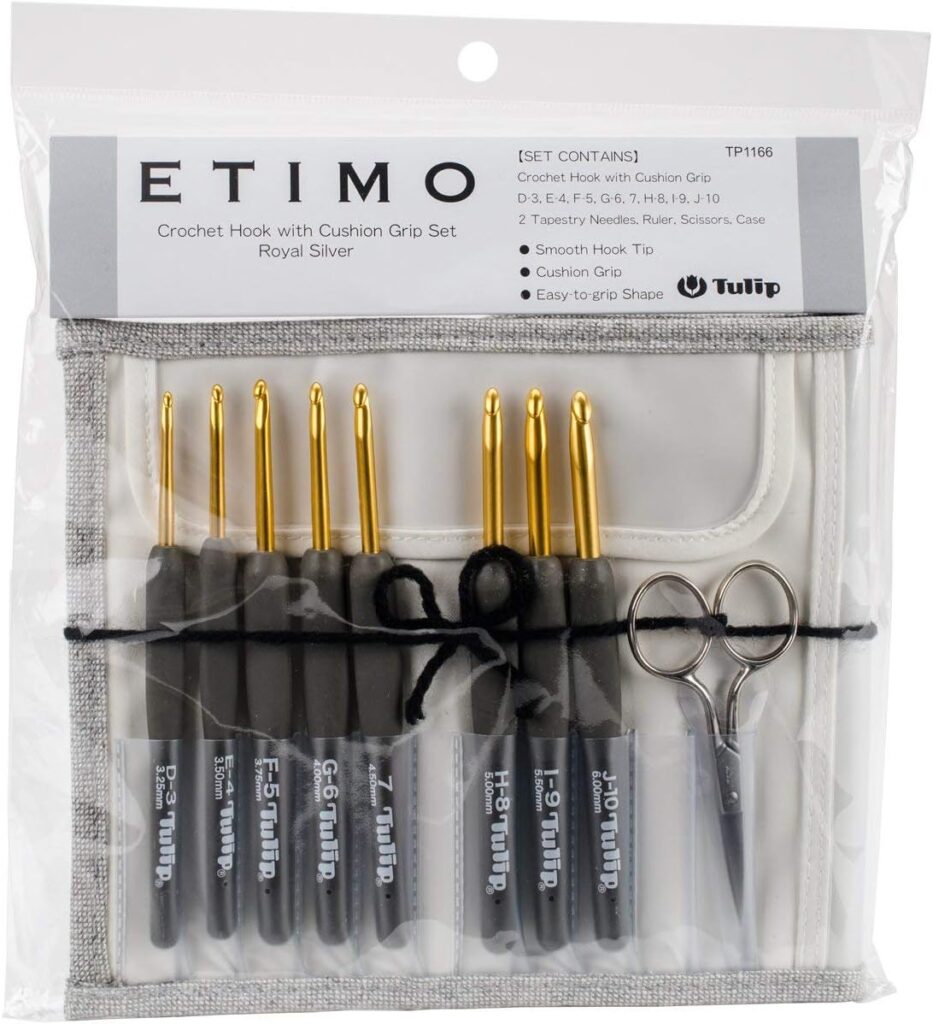Understanding crochet hooks is essential for anyone looking to master the art of crochet. The crochet hook, the tool that gives this beloved craft its name, is central to every stitch and project. Knowing the different types, sizes, and materials of crochet hooks can significantly enhance your crocheting experience.
The more you know about your tools, especially the crochet hook, the better your results will be. From achieving the perfect gauge to ensuring comfort during long crochet sessions, a deep knowledge of crochet hooks can elevate your craftsmanship and help you create beautiful, intricate pieces with ease.
As you explore this guide, you’ll find valuable insights into selecting the right hooks for your projects and some recommendations for the best crochet hooks to suit your needs.
This post may contain affiliate links. This means that if you make a purchase, I will receive a small commission at no extra cost to you. All opinions are my own. You can read my Privacy Policy here.
Leia esse post em português aqui.
You will find in this post…
Get to Know Your Crochet Hook
The crochet hook is the tool you will use to transform yarn and bring your creations to life. Like any tool, it has the power to optimize your time and improve the quality of your work.
To get the most out of your crochet hook, it’s important to understand its anatomy. By familiarizing yourself with each part and its function, you’ll be better equipped to choose the right hook for any project. Let’s take a closer look at these features and their variations.
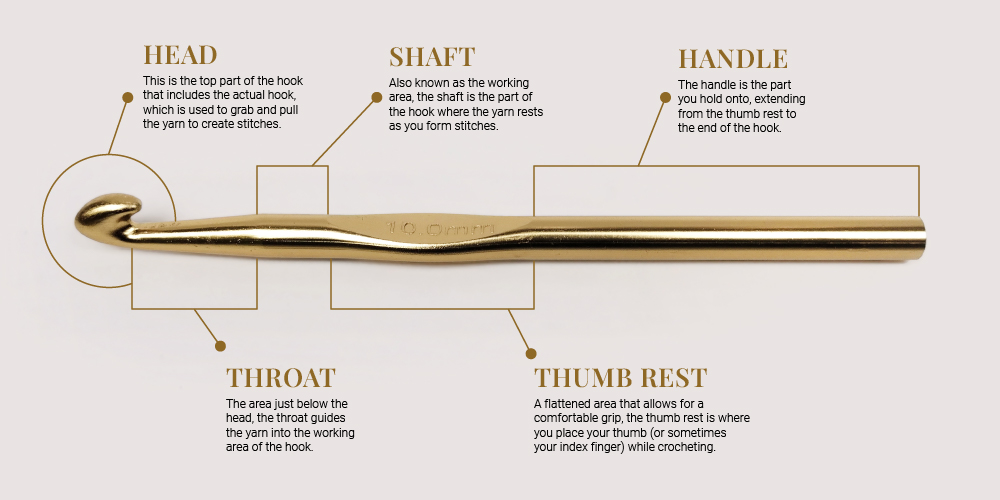
Head
The head is the top part of the crochet hook, which includes the actual hook. It is used to grab and pull the yarn through loops to create stitches. The hook is formed by three parts: the point, lip, and mouth. The shape and size of the head can vary slightly between different hooks.
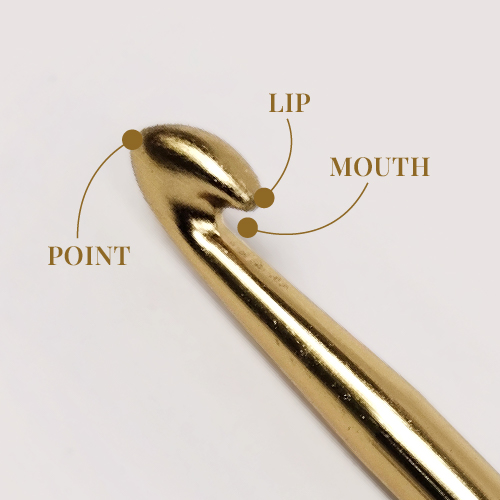
Point
The point is the very tip of the crochet hook. It is used to insert the hook into stitches or loops. Its shape can be smooth (rounded) or sharp (pointy). A sharp point helps in maneuvering through stitches, but it can pose a challenge to beginners since it may split the yarn during the crochet process.
Lip
The lip, or nose, is the curved part just below the point. Its function is to catch and hold the yarn to pull it through loops. The lip’s shape and size can affect how easily it grabs the yarn.
Mouth
Also known as the bowl, the mouth is the hollow part of the hook. It works together with the lip in catching and guiding the yarn through the loops. The size and depth of the mouth may change the way you work the yarn to form the stitches.
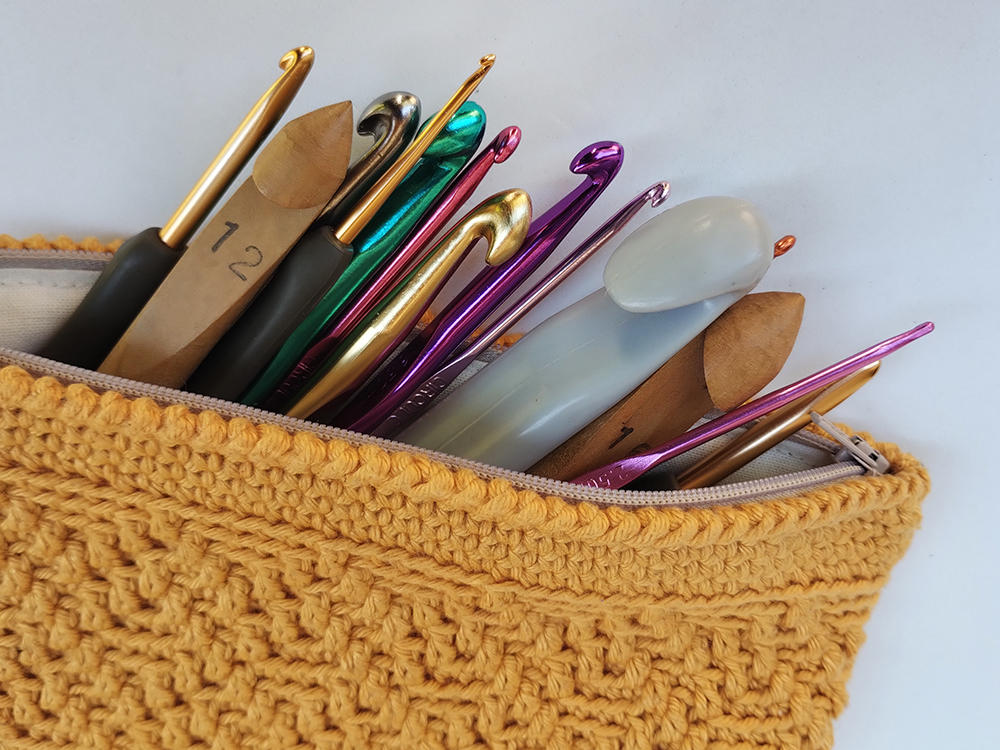
Throat
The throat is the area, just below the head, through which the yarn slides from the hook to the shaft. It’s usually tapered and helps manage the yarn’s tension as it moves through the hook.
Shaft
Also known as the shank or working area, the diameter of the shaft determines the size of the stitches and is what the hook size refers to. For example, a 5 mm hook has a shaft diameter of 5 mm.
Thumb Rest
The thumb rest, or grip, is a flattened area where you place your thumb or sometimes your index finger (depending on your grip style) while crocheting. Holding this part of the hook provides the stability and control necessary for handling the hook. Not every hook has a thumb rest though.
Handle
The handle is the part you hold onto, extending from the thumb rest to the end of the hook. Handles can vary greatly in shape and length. The handle should fit comfortably in your hand, allowing you to crochet for extended periods without discomfort.
For those who crochet with the knife grip, the length of a crochet hook handle plays a crucial role in overall comfort and ease of use, especially considering the size of the crocheter’s hand.
For individuals with larger hands, longer handles can provide a more comfortable grip. If the handle is too short, it might offer less control over the hook and become uncomfortable during extended crocheting sessions. Experimenting with different handle lengths will help you find the best crochet hook for your hand size and crocheting style.
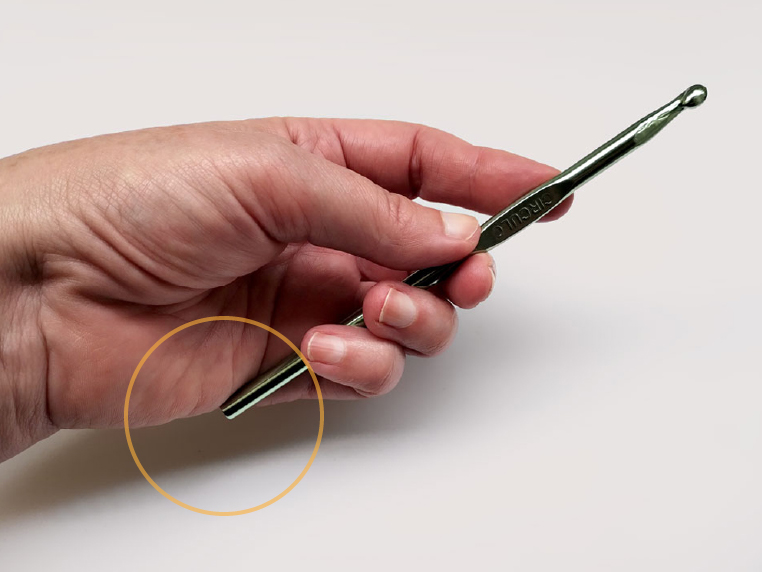

All the parts that make up a crochet hook can vary. As we’ve already seen, its point can be sharp or smooth, and the same goes for the lip. Its handle can be shorter or longer, traditional or ergonomic. Not to mention the different materials, which we’ll look at later.
Inline vs. Tapered Crochet Hooks: What’s the Difference?
Based on their anatomy, we can separate crochet hooks into two main categories: Inline Hooks and Tapered Hooks.
Inline Hooks
Inline hooks have a very distinct shape. The hook’s head is the same width as the shaft, creating a straight, uniform appearance. They also have a flat throat and a prominent lip. Its head is more angular with a well-defined shape and a sharp point, especially the metallic hooks. The best-known inline hooks are the Susan Bates hooks.
Tapered Hooks
Tapered hooks have a more gradual shape. The head tapers down to a narrower throat before widening out again towards the shaft. They also have a rounded throat and the lip is less pronounced. Its head is more rounded and less angular. A well-known example of tapered hooks are the Boye hooks.

We can also find hybrid hooks that combine features from both inline and tapered hooks, aiming to offer the best of both worlds. Hybrid hooks don’t have fixed features, but they typically have a slightly tapered throat for smooth yarn movement, coupled with a more defined lip and point, similar to inline hooks, for better yarn control.
The choice between inline and tapered hooks often comes down to personal preference and the specific requirements of your project. I suggest you try both to see which style feels more comfortable in your hand and suits your crocheting style.
Inline vs. Tapered Comparison Chart
| Feature | Inline Hooks | Tapered Hooks |
| Shape | Head and shaft are the same width, creating a straight, uniform appearance | Head tapers down to a narrower throat before widening at the shaft |
| Control | Provides better control over the yarn | Allows for more fluid movements, suitable for repetitive stitching |
| Tension | Flat throat helps maintain consistent tension | Rounded throat allows the yarn to glide smoothly, potentially reducing hand strain |
| Stitch Uniformity | Produces even, uniform stitches | May result in slightly less uniform stitches, but offers faster crocheting |
| Lip | More pronounced lip, making it easier to catch and pull yarn through loops | Less pronounced lip, offering a smoother yarn-catching process |
| Preferred Use | Good for projects requiring precise, uniform stitches | Ideal for projects that need quick, repetitive stitching |
| Brands | Susan Bates is a well-known brand for inline hooks | Boye is a popular brand for tapered hooks |
| Challenges | Sharp point and pronounced lip can split yarn if not used carefully | Smooth lip may struggle with catching yarn, especially for beginners |
The Various Materials of Crochet Hooks
Besides the variety of shapes, you’ll also find crochet hooks in many different materials. Each material has its own specific characteristics and may be more or less suitable depending on the yarn used or the type of project you’re crocheting. Let’s take a look at the most common materials and what we can expect from each of them:

Aluminum
One of the most popular choices among crocheters, aluminum hooks are available in various brands, sizes, and qualities. Besides being lightweight and durable, they are inexpensive and allow for smooth, fast crocheting. One downside is that they can be slippery with certain yarns.

Steel
Steel hooks are available in smaller sizes and are typically used for detailed work with crochet threads and lace-weight yarns. They are extremely durable and strong but the regular steel hooks might be uncomfortable for long periods of use.

Plastic
Plastic hooks are inexpensive, lightweight, and come in a variety of colors. They are often used in larger sizes and are comfortable to hold. However, they are less durable than metal hooks and can bend or break under pressure, especially in smaller sizes. Additionally, some types of yarn might not slide as smoothly on plastic hooks.
Plastic hooks became popular for crocheting while traveling, especially on airplanes. Unlike metal hooks, plastic hooks are generally allowed in carry-on luggage, as they are considered less likely to pose a security risk.
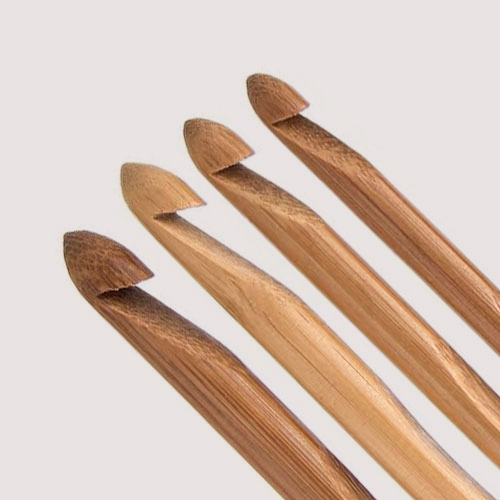
Wood
Wooden hooks are favored for their natural feel and beauty. They come in a range of sizes and various types of wood, including bamboo and exotic woods. Besides being lightweight, they are also warm to the touch and potentially eco-friendly. They can be more expensive and may require occasional maintenance, such as sanding or polishing.

Hybrid
Hybrid hooks combine different materials to take advantage of their unique properties. The most common hybrid hooks feature a metal hook with a soft rubber ergonomic handle. These hooks offer the durability and smoothness of metal with the comfort of an ergonomic handle. They can be more expensive, and the smaller upper part of the hook can be challenging to use. Nevertheless, they are a great option for long projects and for those who need extra comfort and support.
Crochet Hook Materials Comparison Chart
| Material | Types | Pros | Cons | Common Uses |
| Aluminum | Wide range of sizes | Lightweight, durable, inexpensive, smooth crocheting | Can be slippery with certain yarns, cold to the touch | Versatile for all types of projects, great for beginners |
| Steel | Mostly small sizes for fine work | Extremely durable and strong, perfect for detailed work | More rigid, can be uncomfortable for long use | Lacework, doilies, intricate patterns |
| Plastic | Various sizes, often larger hooks | Inexpensive, lightweight, colorful, comfortable to hold | Less durable, can bend or break, yarn may not slide smoothly | Larger projects like blankets or rugs, plane travels |
| Wood | Range of sizes, various woods | Warm to the touch, lightweight, eco-friendly, good grip | More expensive, requires maintenance, can break more easily | Any project, especially for those who enjoy the feel of wood |
| Hybrid | Metal hook with plastic/ergonomic handle | Combines durability and smoothness of metal with comfort | More expensive, smaller hook part can be challenging to use | Long projects, extra comfort and support |
Understanding the Varieties of Crochet Hooks
Traditional Crochet Hooks
Traditional crochet hooks are the most basic in their form. They vary in material and some aspects of their anatomy, but they are essentially shafts with a hook in one end.
Ergonomic Crochet Hooks
Ergonomic crochet hooks are designed to provide maximum comfort and reduce hand fatigue, especially during long crochet sessions. There are two main types: hybrid hooks with a metal hook combined with an ergonomic handle made of soft rubber or other materials, and full anatomical handle hooks that are entirely molded to fit the hand’s natural grip.
Double-Pointed Crochet Hooks
Double-pointed crochet hooks feature a hook on both ends, allowing for unique and versatile crochet techniques. They are particularly useful for working in the round or for certain types of Tunisian crochet.
Tunisian Crochet Hooks
Tunisian crochet hooks, also known as Afghan crochet hooks, are longer than traditional crochet hooks and often come with a stopper or interchangeable cables at the end. These hooks are designed to hold multiple stitches at once, similar to knitting needles. Tunisian crochet combines elements of both crochet and knitting, resulting in a unique, textured fabric. These hooks are essential for anyone interested in exploring this specific crochet technique.

Interchangeable Crochet Hooks
Interchangeable crochet hooks come with detachable hooks and handles, allowing for easy customization of hook size and cable length. They are ideal for versatile projects and allow for easy switching between hook sizes without the need for multiple hooks.
Lighted Crochet Hooks
Lighted crochet hooks have built-in LED lights at the tip, providing extra illumination for working with dark yarns or in low-light conditions. They are perfect for crocheters who require additional visibility for their projects.
Understanding Crochet Hook Sizes
As mentioned earlier, the size of a crochet hook is determined by the diameter of its shaft. This shaft, also known as the working area, standardizes the size of the loop and, consequently, the size of the stitch created with that particular hook. Therefore, the diameter of the shaft directly corresponds to the hook size. For instance, a hook labeled as 6 mm indicates that the diameter of its shaft is 6 mm.

Different Systems for Identifying Crochet Hook Sizes
When it comes to indicating hook sizes, various systems are utilized worldwide. Here’s a breakdown of the different systems:
Brazil (Metric System): In Brazil, where I live, all crochet hooks are sized using the metric system, specifically millimeters (mm).
US (Alphanumeric and Metric Systems): Hook manufacturers in the US utilize an alphanumeric system, incorporating numbers and/or letters, alongside metric sizing, denoted in millimeters (mm).
UK (Old Imperial System): The UK employs an older imperial system using sequential numbers to indicate crochet hook sizes.
Japan (Numeric System): In Japan, a country known for its high-quality crochet hooks, a distinct numeric system is used to indicate crochet hook sizes, differing from both the US and UK systems.
It can be confusing, but the Craft Yarn Council offers this helpful advice:
“Because letter and number sizing vary from company to company, rely on the package millimeter (mm) sizing, which is an accurate measurement.”
The Variety of Crochet Hook Sizes Available
There are many different crochet hook sizes available on the market. The Craft Yarn Council lists 57 sizes, ranging from 0.60 mm to 30 mm, including both regular and steel crochet hooks. However, this number is even larger if we consider the hook sizes available in other countries that do not appear in the Craft Yarn Council’s chart. Additionally, if we also include handmade hooks, this number will increase even further.
Regular Crochet Hooks Conversion Charts
| Millimeter Range* | U.S. Size Range* | UK Size Range (Imperial)** | Suggested Yarn Type* |
| 2 mm | — | 14 | — |
| 2.25 mm | B-1 | 13 | (0 LACE / 1 SUPERFINE) Lace, 10 count crochet thread, Sock, Fingering, Baby |
| 2.50 mm | — | — | (1 SUPERFINE) Sock, Fingering, Baby |
| 2.75 mm | C-2 | 12 | (1 SUPERFINE) Sock, Fingering, Baby |
| 3 mm | — | 11 | (1 SUPERFINE) Sock, Fingering, Baby |
| 3.125 mm | D | — | (1 SUPERFINE) Sock, Fingering, Baby |
| 3.25 mm | D-3 | 10 | (1 SUPERFINE) Sock, Fingering, Baby |
| 3.50 mm | E-4 | — | (2 FINE) Sport, Baby |
| 3.75 mm | F-5 | 9 | (2 FINE) Sport, Baby |
| 4 mm | G-6 | 8 | (2 FINE) Sport, Baby |
| 4.25 mm | G | — | (2 FINE) Sport, Baby |
| 4.50 mm | 7 | 7 | (2 FINE / 3 LIGHT) Sport, Baby, DK, Light Worsted |
| 5 mm | H-8 | 6 | (3 LIGHT) DK, Light Worsted |
| 5.25 mm | I | — | (3 LIGHT) DK, Light Worsted |
| 5.50 mm | I-9 | 5 | (3 LIGHT / 4 MEDIUM) DK, Light Worsted, Worsted, Afghan, Aran |
| 5.75 mm | J | — | (4 MEDIUM) Worsted, Afghan, Aran |
| 6 mm | J-10 | 4 | (4 MEDIUM) Worsted, Afghan, Aran |
| 6.50 mm | K-10 ½ | 3 | (4 MEDIUM / 5 BULKY) Worsted, Afghan, Aran, Chunky, Craft, Rug |
| 7 mm | — | 2 | (5 BULKY) Chunky, Craft, Rug |
| 7.5 mm | — | 1 | (5 BULKY) Chunky, Craft, Rug |
| 8 mm | L-11 | 0 | (5 BULKY) Chunky, Craft, Rug |
| 9 mm | M/N-13 | 00 | (5 BULKY) Chunky, Craft, Rug |
| 10 mm | N/P-15 | 000 | (5 BULKY / 6 SUPER BULKY) Chunky, Craft, Rug, Bulky, Roving |
| 11.50 mm | P-16 | — | (6 SUPER BULKY) Bulky, Roving |
| 12 mm | — | — | (6 SUPER BULKY) Bulky, Roving |
| 15 mm | P/Q | — | (6 SUPER BULKY / 7 JUMBO) Bulky, Roving, Jumbo |
| 15.75 mm | Q | — | (7 JUMBO) Jumbo, Roving |
| 16 mm | Q | — | (7 JUMBO) Jumbo, Roving |
| 19 mm | S | — | (7 JUMBO) Jumbo, Roving |
| 25 mm | T/U/X | — | (7 JUMBO) Jumbo, Roving |
| 30 mm | T/X | — | (7 JUMBO) Jumbo, Roving |
**Source: The Needle Store
Steel Crochet Hook Sizes
Steel crochet hooks are made from durable steel, allowing them to be produced in very small sizes, which is essential for creating detailed patterns and small, precise stitches. Their strong and durable nature maintains their shape and effectiveness even with prolonged use.
Steel crochet hooks and regular crochet hooks have different sizing systems. Steel crochet hooks are typically sized by numbers, with smaller numbers indicating larger hooks and larger numbers indicating smaller hooks.
The distinction is important to note, as using the wrong type of hook for your project can affect the final appearance and texture of the crochet work.
Steel Crochet Hooks Conversion Charts
| Millimeter Range* | U.S. Size Range* |
| 3.50 mm | 00 |
| 3.25 mm | 0 |
| 2.75 mm | 1 |
| 2.70 mm | 00 |
| 2.55 mm | 0 |
| 2.35 mm | 1 |
| 2.25 mm | 2 |
| 2.20 mm | 2 |
| 2.10 mm | 3 |
| 2 mm | 4 |
| 1.90 mm | 5 |
| 1.80 mm | 6 |
| 1.75 mm | 4/0 |
| 1.70 mm | 5 |
| 1.65 mm | 7 |
| 1.60 mm | 6 |
| 1.50 mm | 8/7/2 |
| 1.40 mm | 9/8 |
| 1.30 mm | 10 |
| 1.25 mm | 9/4 |
| 1.15 mm | 10 |
| 1.10 mm | 11 |
| 1.05 mm | 11 |
| 1 mm | 12/6 |
| 0.95 mm | 13 |
| 0.90 mm | 14/8 |
| 0.85 mm | 13 |
| 0.75 mm | 14/10 |
| 0.60 mm | 12 |
Selecting the Right Hook Size
The appropriate size of a crochet hook is related to the yarn selected and the desired tension for the project. As a general guideline, use the hook size indicated on the yarn label as a starting point. However, there are some critical factors to consider.
Check Your Gauge
Achieving the correct gauge is essential for the success of most crochet projects. If the gauge specified in the pattern is not met with the recommended hook size, you will need to make adjustments. While you can adjust your tension while making the stitches, the common solution is to change your crochet hook size.
If your gauge swatch turns out smaller than recommended, try using a larger hook. If it turns out too big, switch to a smaller hook.
Variations in hook size can significantly alter the dimensions and texture of the final piece, so it is imperative to verify your gauge with a swatch before proceeding with the project.

Balance Your Tension
Balancing tension is a critical aspect of crochet that affects the uniformity and appearance of the finished work. Crocheters who exhibit a naturally tight tension may benefit from using a larger hook than suggested to produce a fabric that is more pliable and less dense. Conversely, those with a looser tension may find that a smaller hook enhances stitch definition and prevents the fabric from appearing overly loose or floppy.
Useful Tip: Avoid changing hooks in the middle of a project, even if the hooks are labeled as the same size. Slight variations between brands can affect the consistency of your stitches and the overall look of your finished piece. Stick with one hook throughout to ensure uniformity.
The Benefits of Using Quality Hooks
Investing in quality crochet hooks can significantly enhance your crocheting experience. High-quality hooks are typically made from durable materials that glide smoothly through the yarn, reducing hand fatigue and allowing for a more enjoyable and efficient crafting session.
The ergonomic design of many quality hooks also provides better grip and comfort, which is particularly beneficial for long projects. With a well-made hook, your stitches are more likely to be consistent, leading to a neater and more professional-looking finished piece.
Moreover, quality crochet hooks are designed to last, making them a worthwhile investment for any crocheter. By choosing high-quality hooks, you increase the odds that your tools will remain reliable and effective for many years, saving you money in the long run. Here are some top-rated crochet hooks to consider:
Recommended Crochet Hooks
Susan Bates Silvalume Crochet Hooks
Boye Tapered Aluminum Crochet Hooks
Clover Amour Ergonomic Crochet Hooks
Clover Amour Steel Crochet Hooks
Tulip Etimo Ergonomic Crochet Hooks
Essential Tips for Choosing and Using Crochet Hooks
Understand Hook Anatomy: Familiarize yourself with the parts of a crochet hook to better understand how each component affects your crocheting.
Explore Different Hook Types and Materials: Don’t be afraid to experiment with different hook types, sizes, and materials. The more familiar you become with various hooks, the easier it will be to choose the best one for each project.
Use the Right Size for the Yarn: Follow the recommended hook size on the yarn label, but be prepared to adjust based on your tension and the desired outcome of your project.
Check Your Gauge: Always create a gauge swatch before starting your project, and adjust your hook size accordingly if your gauge doesn’t match the pattern.
Invest in Quality Hooks: High-quality hooks can enhance your crocheting experience by providing smoother motion, consistent stitches, and greater durability.
By keeping these tips in mind, you’ll be well-equipped to choose the right crochet hooks for any project, ensuring a smoother, more enjoyable crocheting experience.
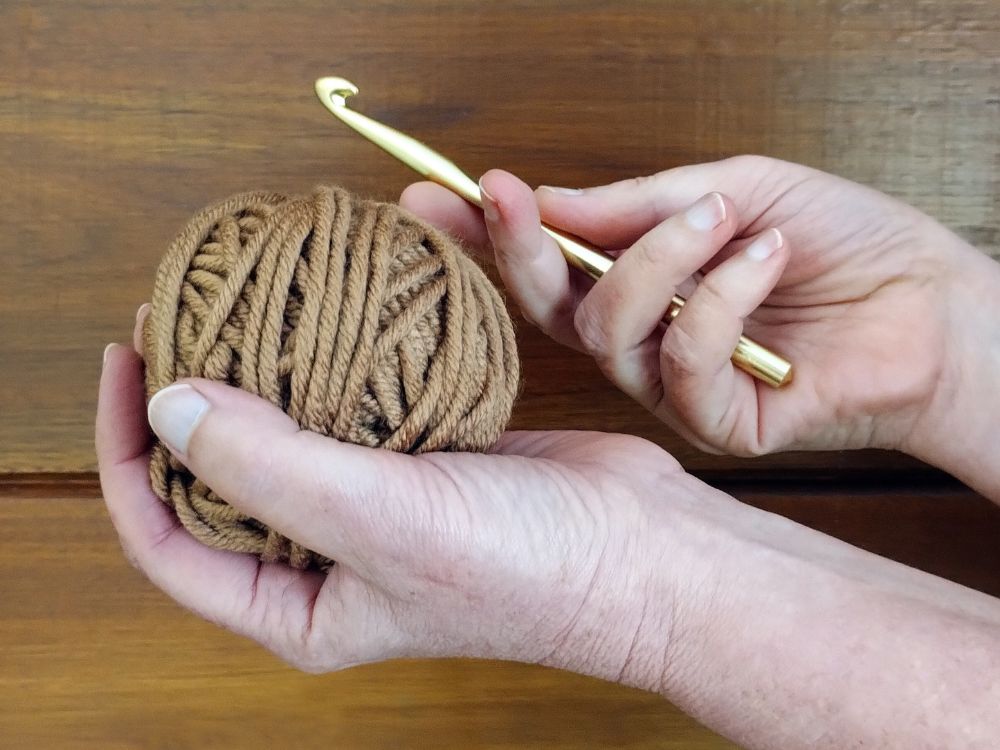
How to Hold a Crochet Hook and Yarn
Learn the best techniques for holding your crochet hook and yarn. Enhance your crochet experience with our beginner-friendly guide.
FAQs about Crochet Hooks
Start with the hook size recommended on the yarn label. Adjust if necessary by making a gauge swatch to ensure your stitches match the pattern’s gauge.
Inline hooks have a uniform width and a sharp point, providing precise control. Tapered hooks have a rounded throat and a less pronounced lip, allowing for smoother, faster stitching.
Crochet hooks come in various materials, including aluminum, steel, plastic, and wood. Each material has unique properties that may suit different projects and preferences.
Using ergonomic crochet hooks can help reduce hand fatigue. These hooks are designed to provide a comfortable grip and ease the strain during long crocheting sessions.
The main parts of a crochet hook include the head, point, lip, mouth, throat, shaft, thumb rest, and handle. Each part plays a role in your crocheting process.
You should opt for plastic hooks when traveling by plane, as they are less likely to pose a security risk than metal hooks. Always check the specific regulations of your airline before traveling.
Besides being more durable, high-quality crochet hooks provide smoother motion, reduce hand fatigue, and ensure consistent stitches.
It’s best to avoid changing hooks mid-project. Even if they are the same size, the slightest variation between brands can affect stitch consistency and the overall look of your work.





